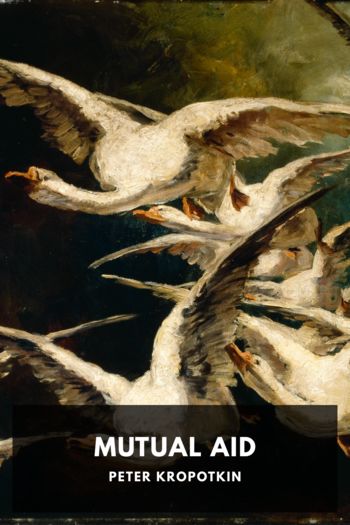Mutual Aid, Peter Kropotkin [fiction novels to read .txt] 📗

- Author: Peter Kropotkin
Book online «Mutual Aid, Peter Kropotkin [fiction novels to read .txt] 📗». Author Peter Kropotkin
Each time, however, that an attempt to return to this old principle was made, its fundamental idea itself was widened. From the clan it was extended to the stem, to the federation of stems, to the nation, and finally—in ideal, at least—to the whole of mankind. It was also refined at the same time. In primitive Buddhism, in primitive Christianity, in the writings of some of the Mussulman teachers, in the early movements of the Reform, and especially in the ethical and philosophical movements of the last century and of our own times, the total abandonment of the idea of revenge, or of “due reward”—of good for good and evil for evil—is affirmed more and more vigorously. The higher conception of “no revenge for wrongs,” and of freely giving more than one expects to receive from his neighbours, is proclaimed as being the real principle of morality—a principle superior to mere equivalence, equity, or justice, and more conducive to happiness. And man is appealed to to be guided in his acts, not merely by love, which is always personal, or at the best tribal, but by the perception of his oneness with each human being. In the practice of mutual aid, which we can retrace to the earliest beginnings of evolution, we thus find the positive and undoubted origin of our ethical conceptions; and we can affirm that in the ethical progress of man, mutual support not mutual struggle—has had the leading part. In its wide extension, even at the present time, we also see the best guarantee of a still loftier evolution of our race.
Appendix I Swarms of Butterflies, Dragonflies, etc.M. C. Piepers has published in Natuurkunding Tijdschrift voor Neederlandsch Indië, 1891, Deel L. p. 198 (analyzed in Naturwissenschaftliche Rundschau, 1891, vol. vi, p. 573), interesting researches into the mass-flights of butterflies which occur in Dutch East India, seemingly under the influence of great draughts occasioned by the west monsoon. Such mass-flights usually take place in the first months after the beginning of the monsoon, and it is usually individuals of both sexes of Catopsilia (Callidryas) crocale, Cr., which join in it, but occasionally the swarms consist of individuals belonging to three different species of the genus Euphoea. Copulation seems also to be the purpose of such flights. That these flights are not the result of concerted action but rather a consequence of imitation, or of a desire of following all others, is, of course, quite possible.
Bates saw, on the Amazon, the yellow and the orange Callidryas “assembling in densely packed masses, sometimes two or three yards in circumference, their wings all held in an upright position, so that the beach looked as though variegated with beds of crocuses.” Their migrating columns, crossing the river from north to south, “were uninterrupted, from an early hour in the morning till sunset” (Naturalist on the Amazon, p. 131).
Dragonflies, in their long migrations across the Pampas, come together in countless numbers, and their immense swarms contain individuals belonging to different species (Hudson, Naturalist on the La Plata, pp. 130 seq.). The grasshoppers (Zoniopoda tarsata) are also eminently gregarious (Hudson, l.c. p. 125).
II The AntsPierre Huber’s Les fourmis indigènes (Genève, 1810), of which a cheap edition was issued in 1861 by Cherbuliez, in the Bibliothèque Genevoise, and of which translations ought to be circulated in cheap editions in every language, is not only the best work on the subject, but also a model of really scientific research. Darwin was quite right in describing Pierre Huber as an even greater naturalist than his father. This book ought to be read by every young naturalist, not only for the facts it contains but as a lesson in the methods of research. The rearing of ants in artificial glass nests, and the test experiments made by subsequent explorers, including Lubbock, will all be found in Huber’s admirable little work. Readers of the books of Forel and Lubbock are, of course, aware that both the Swiss professor and the British writer began their work in a critical mood, with the intention of disproving Huber’s assertions concerning the admirable mutual-aid instincts of the ants; but that after a careful investigation they could only confirm them. However, it is unfortunately characteristic of human nature gladly to believe any affirmation concerning men being able to change at will the action of the forces of Nature, but to refuse to admit well-proved scientific facts tending to reduce the distance between man and his animal brothers.
Mr. Sutherland (Origin and Growth of Moral Instinct) evidently began his book with the intention of proving that all moral feelings have originated from parental care and familial love, which both appeared only in warm-blooded animals; consequently he tries to minimize the importance of sympathy and cooperation among ants. He quotes Büchner’s book, Mind in Animals, and knows Lubbock’s experiments. As to the works of Huber and Forel, he dismisses them in the following sentence; “but they [Büchner’s instances of sympathy among ants]





Comments (0)